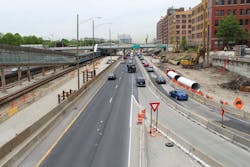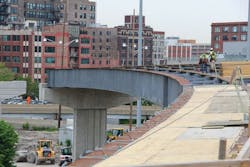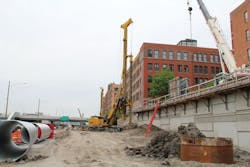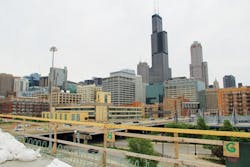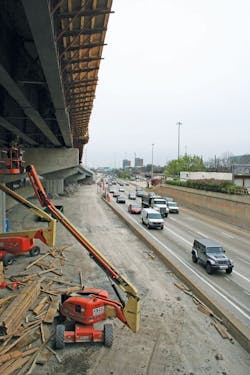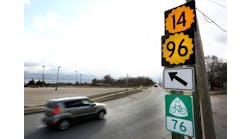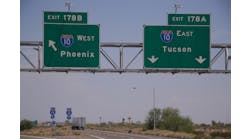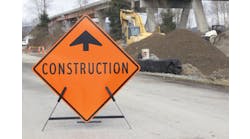By: Brian W. Budzynski
Live near any major city and you’re inevitably going to deal with a few unpleasant things, primary of which, for anyone who holds down a job or attends school or has a life outside the home at all, is likely going to be traffic congestion.
And Chicagoans seem to have it worse than most.
Chicago proper is home to 2.7 million denizens, while its outlying metropolitan and suburban landscape tack on an additional 7 million. Traffic flow in and out of the city has been a source of frustration for area residents since time forgotten—to say nothing of the burden placed on the city’s road arteries by commerce (the city is the world’s third largest intermodal port, behind only Hong Kong and Singapore).
Forming a sort of gateway to downtown access is the Jane Byrne Interchange. Skirting the near west and near north sides of the city, the interchange, which was initially built in the 1950s and 1960s for a significantly more modest population level, is the confluence of I-290 (the Eisenhower Expressway), I-90 (the Kennedy Expressway), I-94 (the Dan Ryan Expressway) and Congress Parkway, which enters the city’s Loop over the Chicago River in a direct feed off the Eisenhower. This tight-packed area withstands some 400,000 vehicles per day, and traffic surges during peak commuting hours and amidst major events, such as home games for the Chicago Bears and concerts held at Wrigley Field, Soldier Field or Northerly Island, can push that already extraordinary number even higher. Travel delays as a direct result of the current interchange configuration cause an estimated 17 million lost hours per year, which translates to a time-dollar value of more than $400 million.
A $475 million project to reconstruct and reconfigure the interchange began full-bore construction in 2015, in the first of three planned construction phases.
The WB flyover bridge is expected to be open to traffic by this construction season’s end.
Up to now
In order to minimize the project’s effects on the interchange, the planned construction phases were sequenced to address the worst issues first and work forward from there. Phase 1 consists of reconstruction, addition or restoration of cross-road bridges, including those at Morgan Street, Harrison Street and Halsted Street. Most notably, Phase 1 includes the erection of a $56 million north-to-west flyover bridge to carry northbound I-90/94 traffic above the main lock of the interchange, and fluidly down to a merge with westbound I-290 traffic flowing out of Congress Parkway and the downtown area. Phase 2 will consist of the reconstruction and widening of I-290 and Congress Parkway to ease merging and aid traffic flow into and out of the city, and Phase 3 will then address the east-west I-90/94 segment, which runs in an ellipsis through the city’s near-west side.
According to IDOT Engineer of Expressway Traffic Operations Matt Daeda, finalizing the phased construction plan was a matter of marrying necessity with practicality. “More than 30 geometric concepts were evaluated during project development,” Daeda told Roads & Bridges. “Most were eliminated due to issues with constructability, mobility, right-of-way needs and utility conflicts.”
Phase 1 work began in 2014 on the Harrison and Halsted Street bridges, and work was brought to fruition on the Morgan Street bridge in that same year. The Peoria Street bridge, which houses a Chicago Transit Authority (CTA) Blue Line Station (as does the Halsted Street bridge), was completed in the fall of 2015. Shortly thereafter, the Harrison Street bridge, built from scratch, was opened to traffic in advance of utility and grade work that would precede the rise of the first unit of the flyover bridge that would flow above it.
The north-to-west flyover bridge project got underway in early 2015 with the in-place casting and placement of most of the bridge’s 12 piers, which were sequenced to run off the east side of the Dan Ryan, intercede through the current looping I-290 fly-under ramp as well as the ingress and egress lanes of Congress Parkway, and then across and into the north edge of westbound I-290. (To get a simple picture in mind, imagine holding a boomerang with the curve on your left.) The bridge is planned as a two-lane corridor, with 12-ft lanes and 10-ft inside and outside shoulders. Depths on the 120-ft beams were measured to match each respective unit’s position: The units which approach the interchange were cast at 70 in.; those that traverse the interchange (65 ft above it) were cast at 90 in.; the portion to run over Halsted Street came down to 64 in.; and the final units, which will duck underneath Peoria Street and join the Eisenhower, dropped to 48 in.
As of summer 2015, the unit that runs over the interchange (Unit 4) was the only one installed.
Drilling site for the 12th pier caisson.
What’s going on
The 2016 construction season opened with a rush toward meeting the predetermined goal of having the flyover bridge open to traffic by season’s end.
“Last year, we were starting our 12 piers,” Tony Quigley, P.E., IDOT Engineer of Project Implementation, told Roads & Bridges. “Now we’ve got 11 of the piers in place and we’re drilling the caissons for the 12th pier right next to the Eisenhower.”
The flyover’s deck is presently half completed, and rebar and formwork for the portion of the bridge that runs directly over I-290 (the 189-ft Unit 4) is progressing. Beam installation is likewise ongoing.
“We’ve got beams for the first four units up,” Quigley said. “The Unit 5 beams we started installing the first week of June, when it’s scheduled to go up and over the ramps. The last unit will be toward the end of August, possibly September, depending on how well we stick to the schedule. We’re certainly working to have this bridge done and, fingers crossed, open by the end of this construction season.”
A view of downtown Chicago from the northwest I-90/94 flyover bridge.
The successful opening of the flyover is expected to generate significant and immediate alleviation of a sizable portion of the interchange’s congestion issues.
“We’re anticipating a 50% reduction in traffic delays coming off the Dan Ryan,” Steve Travia, IDOT Engineer of Operations, told Roads & Bridges. “We’ve had a very robust traffic management plan in place, and have been monitoring progress throughout.”
Work on the Taylor Street bridge is expected to be completed in 2016, and work on the auxiliary lane that will tie the flyover into I-290 beneath the Peoria Street bridge is likewise in progress. Utility work along the Eisenhower’s north bank is buttoned up, and auxiliary lane construction is presently taking place opposite the University of Illinois-Chicago campus.
Crews were able to take full advantage of a mild winter to make steady progress, which otherwise, given the norm for Windy City weather, would have had to wait until spring.
“The 2015-2016 winter was fantastic,” Quigley said. “We were able to do utility and retaining wall work and some work on the Harrison Street bridge. We also managed to complete the foundations and stem for pier 11 of the flyover.”
Traffic flowing northbound on Chicago’s Dan Ryan Expressway.
What’s next
The Roads & Bridges editorial staff was fortunate to witness much of the progress achieved thus far firsthand during a site visit in late May of this year (a record of which can be found in a series of videos at www.roadsbridges.com/videos).
Since that time, progress has continued.
Work on storm sewers, drainage and retaining wall erection is proceeding according to schedule along the north side of westbound I-290, presently seeing work between Morgan and Peoria streets. The month of June also saw the letting of two large contracts that will see the overall interchange project steam into its next phase: A $22.745 million letting for the westbound bridge that carries Congress Parkway out of the city, as well as the northeast portion of the flyover that will funnel Dan Ryan traffic heading eastbound into the Loop; and a $9.8 million contract for the stretch of road between Halsted and Racine. Work on the new bridge contract will begin later this fall—“That northeast ramp carries about 3,500 vehicles a day,” Quigley said. “We anticipate that being done sometime in the fall of 2017”—while the road work is expected to dig in by April 2017.
As the auxiliary lanes and the NW flyover begin to come together, IDOT officials are already looking even further ahead to letting contracts for the eastbound Eisenhower, and what some consider the overall project’s pièce de résistance: The Phase 3 correction and reconstruction of the I-90/94’s present 12-mile lane imbalance, which is responsible for 17 million hours lost to delay per year at a time-dollar value of $418 million.
Traffic merge onto Eisenhower Expressway.
About The Author: Budzynski is Managing Editor for Roads & Bridges
